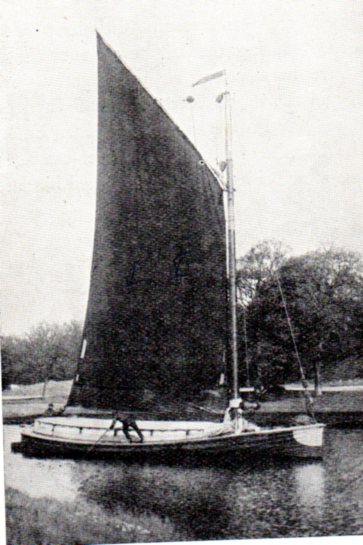There are many distinctive things about the Norfolk wherry. For a start it had only one sail, with one spar, a gaff (the mast does not count as a spar). The foot of the sail was loose (i.e. there was no boom). The sail was always black on a commercial vessel, although the pleasure wherry were yachts which appeared at the end of the 19th century and had white sails. There was a counter balanced mast held up by a single forestay, so the mast could easily be lowered to navigate under the low bridges of the Broadland rivers. The hinge where the mast meets the deck was called the tabernacle. As you can see on this photograph the vessel was manoeuvred round the twists and turns of the narrow rivers with the aid of a ‘quant’. This was used rather as a punt pole is used, only the man holding it would walk along the narrow deck alongside the cargo hatch, holding the quant against his chest. The wherry could be handled by just one man, though a man and a boy was a more common crew.
All wherries but one were built of clinker. This form of construction has overlapping strakes, giving a more subtle line than carvel. With carvel the timbers are abutted giving a smooth hull. As I say, all wooden wherries except one were clinker built, and it is rather unfortunate that the one is is the Wherry Trust’s preserved craft Albion. There is a second wherry called Maud which has been preserved privately, and she is clinker built. At the time Albion was being preserved the hull of Maud was still being used for dredging operations by the firm May Gurney.
There was a small cabin at the stern of a commercial wherry with two bunks for the wherry skipper and his mate. In the early years of the nineteenth century it was usual for the wherryman to live aboard. The mate would normally be his wife and somehow the couple managed to bring up a family in these cramped quarters. Later it became normal for the wife to live in a riverside cottage, leaving her husband to handle the wherry. This could be done single-handed if the wherryman preferred to avoid the expense of a mate, or alternatively he could sail with his eldest child to help navigate the vessel. A paid crewman would have been an unsustainable expense.
Beside the two bunks there was a stove for cooking. This was alright for the open river, but in port at Yarmouth all ships were prohibited from lighting fires because of the risk of conflagration. Cooking could be done ashore in huts provided for the purpose, but in winter the cold must have been terrible, because the cabin would have no heat. This must have been an added incentive to leave Yarmouth for the open river. Wherries often travelled during the hours of darkness but they never had navigation lights. Although the wherry was most commonly used on the rivers of the Yare basin, viz. the Yare, Bure, Waveney, Thurne, and Ant they also made short sea voyages. Although Lowestoft was accessible from the river Waveney, a sea voyage was much shorter and if the weather was fair, easier. Wherries also went south as far as Southwold and up the river Blyth. A wherry called the Star was used to carry coal from Southwold to Halesworth until 1911. Locks made the river navigable, and these were built on the river Blyth in the 18th century.
The origin of the Norfolk wherry are lost in the past, but we can say that the development from the Norfolk keel, which had a square-rigged sail, took place in the second half of the 18th century. The high point of the wherry was in the 19th century. In 1875 there were 112 wherries registered at Great Yarmouth. By the First World War there were about 70 trading on the Norfolk Broads. By 1949 there were none left under sail, although a few were still being used as lighters or dumb barges. The last wherry built was the Ardea, a pleasure wherry, whose hull is of varnished teak. This was in 1927, about 30 years after the last of the commercial wherries were constructed.
JOSEPH MASON
